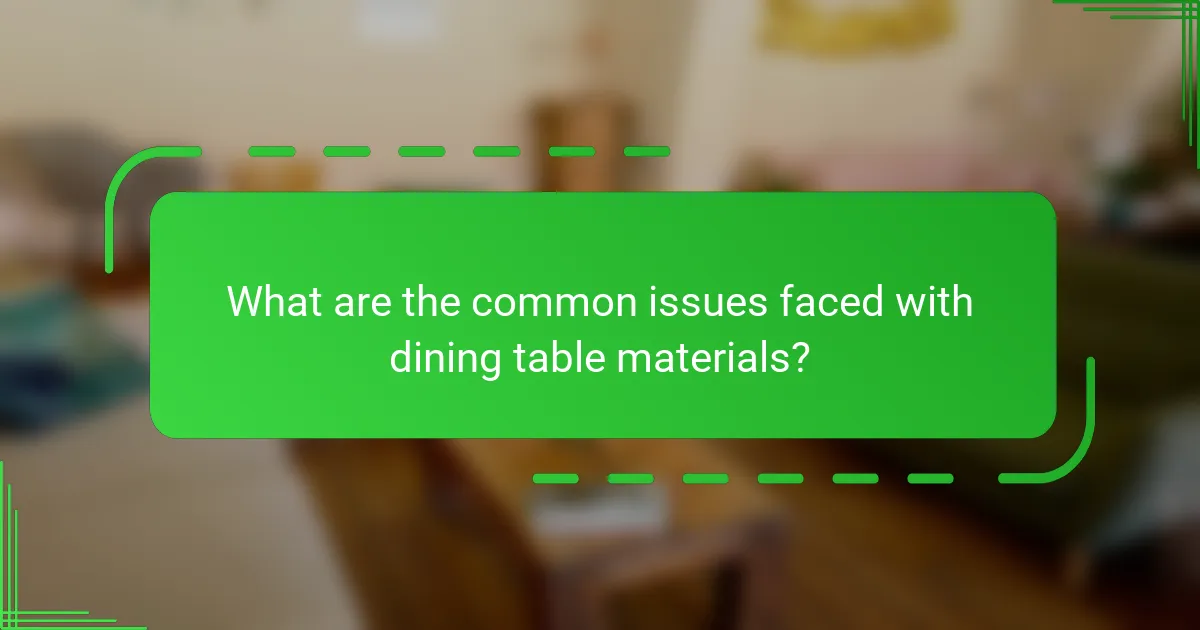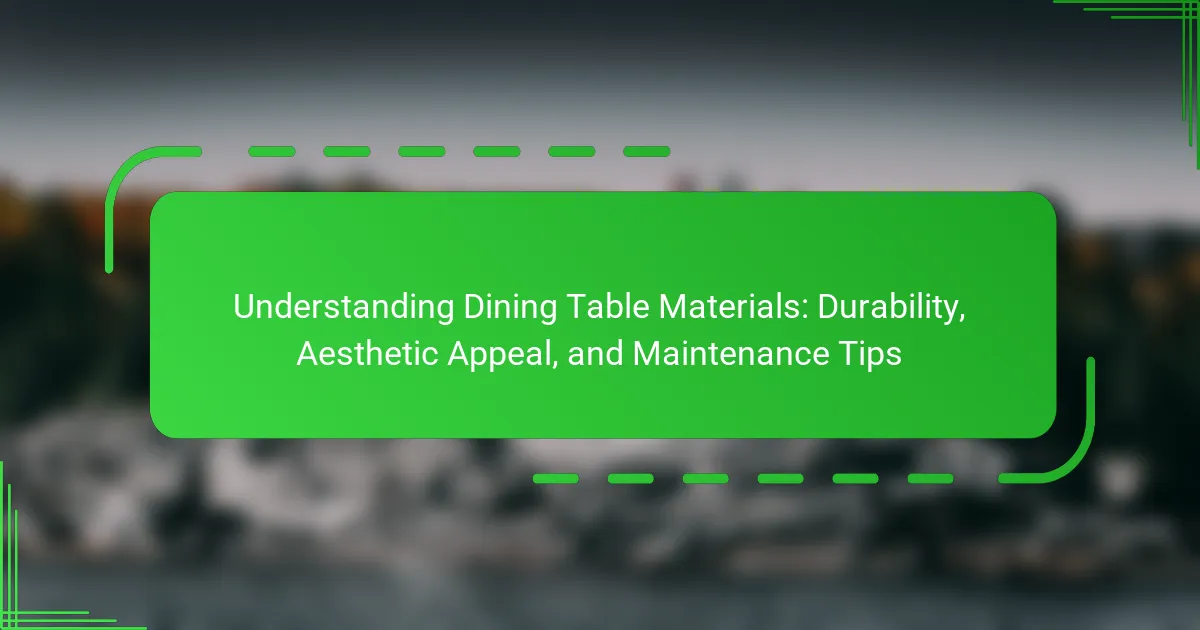Dining tables are essential furniture pieces that can be constructed from various materials, each with distinct characteristics affecting durability, aesthetic appeal, and maintenance requirements. Common materials include wood, metal, glass, stone, and laminate, each offering unique advantages and disadvantages. Wood is valued for its warmth and durability but requires regular upkeep, while metal provides a modern look with minimal maintenance. Glass tops create an illusion of space but may need frequent cleaning, and stone materials like marble and granite are recognized for their elegance and resilience. Understanding the strengths and vulnerabilities of each material is crucial for selecting the right dining table that fits lifestyle needs and usage frequency.

What are the different materials used for dining tables?
Dining tables can be made from various materials, each offering unique characteristics. Common materials include wood, metal, glass, and stone. Wood is popular for its warmth and durability, with options like oak, maple, and walnut. Metal tables often feature sleek designs and are known for their strength. Glass tops provide a modern look and can create an illusion of space. Stone materials, such as marble or granite, are valued for their elegance and durability. Each material has distinct maintenance needs, impacting their longevity and aesthetic appeal.
How do various materials impact the durability of dining tables?
Different materials significantly impact the durability of dining tables. Solid wood is known for its strength and longevity. It can withstand heavy use and is repairable if damaged. Metal tables offer high durability and resistance to wear. They are less prone to scratches and dents. Glass tables, while aesthetically pleasing, are more fragile and can break easily. Laminates provide a cost-effective option but may not last as long as solid wood or metal. Research indicates that solid wood tables can last decades with proper care, while glass may require more frequent replacement due to its susceptibility to damage.
What are the durability characteristics of wooden dining tables?
Wooden dining tables are known for their durability characteristics, which include resistance to wear, strength, and longevity. Hardwoods like oak and maple are particularly resilient. They can withstand daily use and resist scratches and dents. Additionally, wooden tables can be refinished to restore their appearance over time. The natural grain of wood also helps hide minor imperfections. Proper maintenance, such as regular polishing, enhances their durability. Studies show that well-cared-for wooden tables can last for generations.
How does metal compare to wood in terms of durability?
Metal is generally more durable than wood. Metal is resistant to warping, cracking, and pests. It withstands extreme weather conditions better than wood. For example, aluminum and stainless steel can last for decades without significant wear. In contrast, wood can suffer from scratches, dents, and moisture damage. Treated hardwoods can improve durability but still require regular maintenance. Studies show that metal furniture often has a longer lifespan than wood furniture. Thus, for durability, metal is usually the superior choice.
What role do synthetic materials play in the durability of dining tables?
Synthetic materials enhance the durability of dining tables by providing resistance to scratches, stains, and moisture. These materials, such as laminate and acrylic, are engineered to withstand daily wear and tear. They often have a non-porous surface that prevents liquids from penetrating, reducing the risk of damage. Additionally, synthetic materials can be manufactured to mimic the appearance of natural wood while offering greater longevity. Studies show that tables made with high-quality synthetic surfaces can last significantly longer than those made from traditional materials. This durability makes synthetic materials a practical choice for families and high-traffic areas.
What aesthetic appeal do different dining table materials offer?
Different dining table materials offer unique aesthetic appeals. Wood tables provide warmth and a classic look, enhancing a cozy atmosphere. Metal tables can add a modern and industrial feel, often featuring sleek designs. Glass tables create an illusion of space and lightness, making them ideal for smaller areas. Marble tables exude luxury and sophistication, often serving as statement pieces. Each material’s texture and finish can influence the overall decor style, from rustic to contemporary. The choice of material can significantly impact the dining experience and visual harmony within a space.
How does the finish of wood affect its visual appeal?
The finish of wood significantly enhances its visual appeal. A finish can add depth and richness to the wood’s natural grain. It can also alter the color, making it appear warmer or cooler. Different finishes, such as matte, satin, or glossy, create distinct looks. For example, a glossy finish reflects light, enhancing the wood’s beauty. Conversely, a matte finish offers a more subdued appearance. The choice of finish can also highlight unique wood patterns. Additionally, finishes protect the wood, maintaining its aesthetic over time. This protection prevents fading and damage, ensuring lasting visual appeal.
What design options are available with metal dining tables?
Metal dining tables offer various design options. These include industrial, modern, and rustic styles. Industrial designs feature raw finishes and exposed elements. Modern designs often emphasize sleek lines and minimalism. Rustic designs incorporate weathered metal for a vintage appeal. Additionally, metal tables can have various shapes, including rectangular, round, and square. Customization options include different colors and finishes. Some designs combine metal with wood or glass for added aesthetic appeal. Each design option caters to different interior styles and preferences.
How do glass dining tables contribute to modern aesthetics?
Glass dining tables enhance modern aesthetics through their sleek, minimalist design. Their transparency creates an illusion of space, making rooms appear larger and more open. The reflective surface of glass adds a contemporary touch by enhancing light and brightness in a dining area. Additionally, various base materials, such as metal or wood, can be paired with glass to create unique visual contrasts. This versatility allows glass tables to complement diverse interior styles, from industrial to Scandinavian. The clean lines of glass dining tables align with modern design principles that favor simplicity and functionality. Their ability to blend seamlessly with other decor elements further solidifies their role in contemporary aesthetics.
What maintenance practices are necessary for various dining table materials?
Wood dining tables require regular dusting and occasional polishing with furniture oil. This helps maintain their finish and prevents drying out. Avoid using excessive water, as it can warp the wood. Glass tables should be cleaned with glass cleaner and a microfiber cloth. This prevents streaks and maintains clarity. Metal tables need to be wiped down with a damp cloth and dried immediately to avoid rust. For laminate tables, a simple solution of mild soap and water is effective. Avoid harsh chemicals that can damage the surface. Upholstered tables should be vacuumed regularly to remove dust and stains treated promptly with appropriate cleaners. Each material has specific needs to ensure longevity and aesthetic appeal.
How should wooden dining tables be cared for to maintain their quality?
Wooden dining tables should be cared for by regularly cleaning and applying protective finishes. Use a soft, damp cloth to wipe the surface. Avoid harsh chemicals that can damage the wood. Apply a wood conditioner or polish every few months to maintain the finish. This helps prevent cracks and drying. Keep the table away from direct sunlight to avoid fading. Use coasters and placemats to protect against heat and moisture. Regular maintenance extends the table’s lifespan and preserves its appearance.
What cleaning methods are recommended for glass dining tables?
Use a microfiber cloth and a glass cleaner to clean glass dining tables. This method effectively removes fingerprints and smudges. Alternatively, a mixture of vinegar and water can be used as a natural cleaner. Spray the solution on the surface and wipe with a soft cloth. Avoid abrasive materials that can scratch the glass. Regular cleaning prevents buildup and maintains clarity. For stubborn stains, a gentle scrub with a non-abrasive sponge is recommended. Always dry the surface to prevent streaks.
How can metal dining tables be protected from rust and scratches?
To protect metal dining tables from rust and scratches, apply a protective coating. This can include paint, varnish, or a specialized metal sealant. Regularly clean the surface to remove dirt and moisture. Use a soft cloth to avoid scratches during cleaning. Additionally, consider using placemats or coasters to shield the table from direct contact with hot or sharp objects. Storing the table in a dry environment can also prevent rust formation. These methods are effective in maintaining the table’s appearance and longevity.

How can you choose the right dining table material for your needs?
To choose the right dining table material, consider durability, aesthetics, and maintenance. Wood offers warmth and durability but requires regular upkeep. Metal provides a modern look and is highly durable, often needing minimal maintenance. Glass can create an open feel but may require frequent cleaning. Laminate is budget-friendly and easy to maintain but may not offer the same aesthetic appeal as wood or metal. Assess your lifestyle and usage frequency to determine the best fit. For example, families with young children may prefer materials that are easy to clean and resist scratches.
What factors should influence your choice of dining table material?
The choice of dining table material should be influenced by durability, aesthetic appeal, and maintenance requirements. Durability is essential for withstanding daily use and potential spills. For example, hardwoods like oak or maple offer long-lasting strength. Aesthetic appeal relates to how the material complements your home décor. Materials like glass or metal provide a modern look, while wood offers a classic feel. Maintenance requirements affect the ease of cleaning and upkeep. For instance, laminate surfaces are easier to clean than natural wood, which may require periodic sealing. Consider your lifestyle and how often the table will be used. Families with young children may prioritize durability and easy maintenance.
How do lifestyle and usage affect material selection?
Lifestyle and usage significantly influence material selection for dining tables. Different lifestyles require varying durability and maintenance levels. For example, families with children may prefer scratch-resistant materials like laminate or wood. In contrast, individuals who prioritize aesthetics might choose glass or marble for their visual appeal. Usage patterns also dictate the choice; frequent entertainers might select sturdy materials that withstand heavy use. Additionally, lifestyle factors such as cooking habits can lead to preferences for materials that are easy to clean. Thus, understanding lifestyle and usage is essential for selecting appropriate dining table materials.
What aesthetic considerations should be taken into account?
Aesthetic considerations for dining table materials include color, texture, and design. The color should complement the overall decor of the dining area. Texture affects the tactile experience and visual appeal. Design encompasses the shape and style, influencing the table’s presence in the room. Material choices, such as wood, metal, or glass, also impact aesthetics. For example, wood offers warmth and richness, while glass provides a modern look. Additionally, the finish of the material can enhance or diminish its visual impact. These factors collectively contribute to the table’s ability to harmonize with the surrounding environment.
What are the cost implications of different dining table materials?
The cost implications of different dining table materials vary significantly. Solid wood tables typically range from $500 to $2,500, depending on the type of wood and craftsmanship. Laminate tables are more affordable, often priced between $100 and $700. Metal tables can also vary widely, generally costing between $200 and $1,500, influenced by the design and finish. Glass-top tables usually range from $300 to $1,200, with costs influenced by the base material and thickness of the glass. Each material’s price reflects its durability, maintenance needs, and aesthetic appeal. For example, solid wood offers longevity but requires more investment upfront. In contrast, laminate provides a budget-friendly option but may not last as long.
How do prices vary between solid wood and engineered wood tables?
Solid wood tables generally have higher prices compared to engineered wood tables. Solid wood is made from natural timber, which is more costly due to its sourcing and processing. Engineered wood, such as plywood or MDF, utilizes wood fibers and adhesives, making it less expensive to produce.
For instance, solid wood dining tables can range from $800 to $3,000, depending on the type of wood and craftsmanship. In contrast, engineered wood tables typically range from $200 to $1,200. The price difference is also influenced by factors like brand reputation and design complexity.
Market trends indicate that solid wood tables are often viewed as more durable and valuable, contributing to their higher price point.
What is the long-term value of investing in a high-quality dining table material?
Investing in high-quality dining table material provides long-term durability and aesthetic value. High-quality materials, such as solid wood or granite, resist wear and tear over time. They maintain their appearance and functionality, reducing the need for frequent replacements. For instance, solid wood can last for generations with proper care. In contrast, lower-quality materials may warp or scratch easily, leading to additional costs. Additionally, high-quality tables can enhance the overall aesthetic of a dining space, increasing home value. Research indicates that solid wood dining tables can appreciate in value, making them a wise investment.

What are the common issues faced with dining table materials?
Common issues faced with dining table materials include scratches, water damage, and fading. Wood tables can suffer from scratches and dents from everyday use. Glass tables may chip or shatter if not handled carefully. Metal tables can rust if exposed to moisture without proper treatment. Laminates may peel or bubble over time, especially with heat or moisture exposure. Upholstered dining chairs can stain easily and require regular cleaning. Each material has its vulnerabilities that can affect longevity and appearance.
What are the typical problems associated with wooden dining tables?
Wooden dining tables can face several typical problems. Common issues include scratches and dents from everyday use. These marks can mar the surface and diminish aesthetic appeal. Additionally, wooden tables may warp due to changes in humidity and temperature. This warping can lead to uneven surfaces, making them less functional. Another problem is the risk of stains from spills, especially if not promptly cleaned. Wooden surfaces can also be susceptible to termites and other pests. Regular maintenance is required to prevent these issues. Applying protective finishes can help reduce damage and prolong the table’s lifespan.
How can scratches and dents be repaired on wooden surfaces?
To repair scratches and dents on wooden surfaces, start by cleaning the area with a soft cloth. This removes dust and debris. Next, for shallow scratches, use a wood polish or a wax stick that matches the wood color. Rub it into the scratch until it fills the area. For deeper dents, apply a damp cloth over the dent and use a steam iron briefly. This can help the wood fibers swell back into place. Afterward, sand the area lightly with fine-grit sandpaper if necessary. Finally, apply a finish or sealant to protect the repaired area. These methods are effective for maintaining the appearance and integrity of wooden surfaces.
What preventive measures can be taken to avoid warping in wood?
To avoid warping in wood, maintain consistent humidity and temperature levels. Wood is susceptible to changes in moisture and temperature, which can lead to warping. Use a dehumidifier in damp environments and a humidifier in dry conditions. Seal wood surfaces with appropriate finishes to minimize moisture absorption. Store wood products in a climate-controlled area. Regularly inspect wood for signs of moisture damage and address issues promptly. Properly acclimate wood before use to ensure it adjusts to its environment. These measures significantly reduce the risk of warping and prolong the integrity of wood furniture.
What challenges do glass dining tables present?
Glass dining tables present several challenges. They are prone to scratches and chips, which can affect their appearance. Glass surfaces also show fingerprints and smudges easily, requiring frequent cleaning. Additionally, glass tables can be heavy and difficult to move. They may not be suitable for homes with young children due to safety concerns. A glass table can shatter upon impact, posing a risk of injury. Lastly, they can be less durable compared to solid wood or metal options in high-traffic areas.
How can you minimize the risk of breakage with glass tables?
To minimize the risk of breakage with glass tables, use tempered glass instead of regular glass. Tempered glass is stronger and more resistant to impact. Ensure the table is placed on a stable and level surface to prevent tipping. Avoid placing heavy items on the edges of the table, as this increases the chance of breakage. Regularly inspect the glass for any cracks or chips and replace damaged pieces immediately. Use coasters and placemats to protect the surface from scratches and heat. Additionally, avoid sudden temperature changes, as they can cause thermal stress. Following these precautions significantly reduces the likelihood of breakage.
What maintenance tips can help maintain clarity and shine on glass surfaces?
To maintain clarity and shine on glass surfaces, regular cleaning is essential. Use a microfiber cloth to avoid scratches. A mixture of equal parts water and vinegar serves as an effective cleaner. Spray the solution on the glass and wipe in a circular motion. For tougher stains, a glass cleaner with ammonia can be used. Avoid abrasive materials, as they can damage the surface. Additionally, ensure to clean glass surfaces frequently to prevent buildup. Regular maintenance helps preserve both clarity and shine over time.
What practical tips can help you maintain your dining table’s appearance and longevity?
Regularly clean your dining table with a soft, damp cloth. This prevents dust and grime buildup. Use a gentle soap solution for tougher stains. Avoid harsh chemicals that can damage the finish. Apply a suitable wood polish every few months to maintain shine. Use coasters to protect the surface from heat and moisture. Place mats under dishes to prevent scratches. Keep the table away from direct sunlight to avoid fading. Adjust humidity levels in the room to prevent wood warping.
The main entity of this article is dining tables, focusing on their materials, durability, aesthetic appeal, and maintenance practices. The article provides a comprehensive overview of various materials used for dining tables, including wood, metal, glass, and stone, highlighting their unique characteristics and durability factors. It discusses the aesthetic appeal of each material, maintenance requirements, and practical tips for preserving their appearance and longevity. Additionally, the article addresses common issues faced with different materials and offers guidance on selecting the right dining table based on lifestyle and usage.
